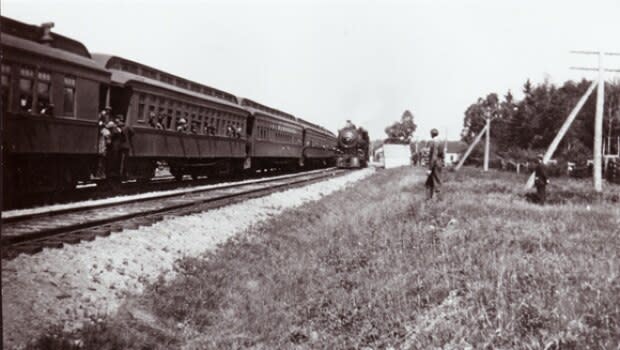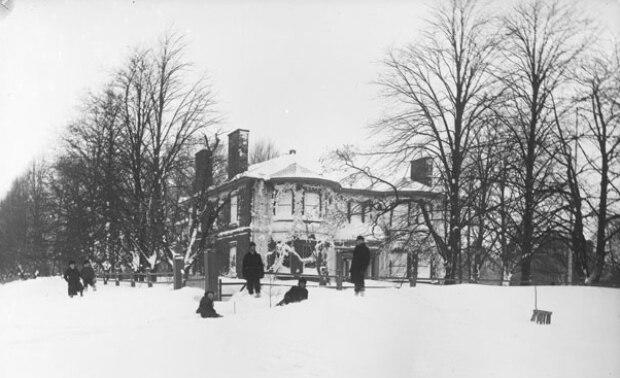P.E.I.'s landscape was very different in the Bygone Days

Reginald "Dutch" Thompson's column The Bygone Days brings you the voices of Island seniors, many of whom are now long-departed. These tales of the way things used to be offer a fascinating glimpse into the past. Every second weekend CBC P.E.I. will bring you one of Dutch's columns.
Biking on the Confederation Trail through P.E.I.'s stunning countryside, it's fun to imagine being in the cab of a steam engine with a former driver like Ernie Deighan, Joe Paquet or Shifty Cantwell.
The "fire man" is working hard to keep up the steam. It's Thursday, hog day, so the train is loaded with pigs on their way to Canada Packers or Swifts over in Moncton. Rounding the turn at Royalty Junction, about nine kilometres to go heading for Charlottetown, when out by the airport we suddenly meet a train with the engine draped in black bunting — a funeral train slowing down at the Sherwood cemetery.

Allan Graham, author of the book A Photo History of the P.E.I Railway, said the original train station on the Sherwood Road near the present-day airport, was called Cemetery because people went out to it by train if someone had died.
"The special train would leave Charlottetown station all draped in black with the casket in the baggage car and the mourners in the passenger car and friends and so on and they would go out and the train would stop, very dignified, at the cemetery station on the Sherwood Road," he said.
'Major thing here on the Island'
"All the mourners would get off, the pallbearers would get the casket from the baggage car and then the whole procession would proceed up the hill to the graveyard," said Graham.

"The train would wait until they were a respectable distance away and then it would start out very slowly and as noiselessly as possible and proceed to Royalty Junction where it would turn very quietly on the Y and then come back in 20 minutes time approximately, to pick up the mourners and all those people at the same cemetery station and proceed back into the Charlottetown station, where they would remove the black bunting and so on from the train.
"It was certainly a major thing here on the Island."
Trains in general were once a central part of Island life. The late Byron Burns, who wrote a book about the railway on P.E.I. called The Narrow Gauge Railway on Prince Edward Island, said that back in the 1930s you could rent the steam engine, the rail cars, the crew — the whole works — for one dollar a mile.
Islanders would rent the trains for events like the hockey specials, carrying fans and teams between Summerside and Charlottetown. It would cost about $95 to rent that train to go to Summerside and back.
Good dog
Burns also told Thompson about Ernie Cameron, who was an engine driver for years on the Island. Cameron used to throw The Guardian newspaper to a dog every morning at the Clyde station. The dog was waiting at the station and then he would trot home with the paper in his mouth to deliver to a farmer.
We had a bit of a livestock there on School Street. — Robert Farquarson
Even bootleggers got in on the action, recounted Roy Clow, who told Dutch a story about a Charlottetown bootlegger who exported rum and oysters to Montreal by train.
"He put it in wooden crates. He put a stamp across the top of the crates — First Class Oysters. And there was an awful big trade in Vernon Bridge that time," Clow said.
'Shipped kegs of rum'
"He shipped kegs of rum, a 10-gallon keg of rum was just the width of an oyster barrel. They'd jam it in tight and he used to put some kind of heavy seaweed and stuff underneath the keg, on top of the keg. And then he had a stamp — Vernon River or West River Oysters — and he'd trip a whole truckload of rum to Montreal wholesalers up there. They all went by train."

It's not just the Confederation Trail. Biking at a leisurely pace around Charlottetown is a great way to see things you might miss when you're zooming around in a car, like old horse barns in backyards.
Some of them have been torn down, such as the old blue horse shed at the Rogers House on Fitzroy Street that's now the Fairholm National Historic Inn next to the old YMCA.
In the bygone days, almost everyone had a horse and a garden, even folks who lived in town like the late Robert Farquarson.
Farms in the city
Farquarson was born in 1913 at 58 School St., which is now Walthen Drive in downtown Charlottetown. His father Ernie was a brakeman and conductor on the railway around 1910. The Farquarsons pastured their cows on the Connolly estate on St. Peters Road where Pope Pius X Church is now.

"Our job was to stay home and do his work. He was a great gardener so you had a great garden, which became our job to look after," Farquarson said.
"He was a farmer, had been a farmer. We had a cow and a pig and a few hens. We had a bit of a livestock there on School Street."
The neighbours didn't mind, Farquarson said, because many of them were also farmers. It's a long way from today — where Charlottetown has a bylaw against raising even backyard chickens.
More P.E.I. news


